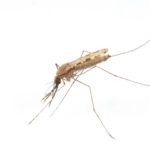Link to Pubmed [PMID] – 2906402
Mol. Gen. Genet. 1988 Sep; 214(1): 42-7
A 135 kDa protein gene and two open reading frames (ORF1 and ORF2) have been cloned from a large plasmid of Bacillus thuringiensis israelensis (Bourgouin et al. 1986). The Escherichia coli recombinant clones containing these genes were highly toxic to larvae of Aedes aegypti, Anopheles stephensi and Culex pipiens. From subcloning experiments it was deduced that the 135 kDa polypeptide alone was responsible for the toxic activity on both A. aegypti and An. stephensi larvae. In contrast, the presence of two polypeptides, the 135 kDa protein and the ORF1 product was required for toxicity to C. pipiens larvae. The minimal toxic fragment of the 135 kDa polypeptide has been delineated. The results indicate that a polypeptide of about 65 kDa, corresponding to an amino-terminal part of the 135 kDa protein is sufficient for toxicity. Sequence comparisons indicate that the ORF1 product may correspond to an N-terminal part of a rearranged 130 kDa protein.


